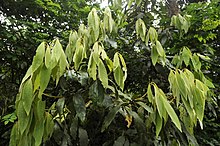

Leaf flushing or leaf out is the production of a flush of new leaves typically produced simultaneously on all branches of a bare plant or tree. Young leaves often have less chlorophyll and the leaf flush may be white or red, the latter due to presence of pigments, particularly anthocyanins. Leaf flushing succeeds leaf fall, and is delayed by winter in the temperate zone or by extreme dryness in the tropics. Leaf fall and leaf flushing in tropical deciduous forests can overlap in some species, called leaf-exchanging species, producing new leaves during the same period when old leaves are shed or almost immediately after. Leaf-flushing may be synchronized among trees of a single species or even across species in an area. In the seasonal tropics, leaf flushing phenology may be influenced by herbivory and water stress.
Red leaf flush
In tropical regions, leaves often flush red when young and in the phase of expansion to mature size. Red flushing is frequent among woody species, reported from 20 to 40% of the woody species in a site in Costa Rica, in 36% of species in Barro Colorado Island, Panama, about 49% of species in Kibale National Park, Uganda, and in 83 of 250 species in Southern Yunnan, China. The red coloration is primarily due to the presence of anthocyanins. Various hypotheses have been advanced to explain red flushing. The herbivore defense hypothesis suggests that the red coloration may make the leaves less likely to be attacked by insects as they are cryptic to herbivores that are blind to the red part of the spectrum. It has also been hypothesised that the anthocyanins may reduce light stress or fungal attacks on leaves. A recent study in tropical forest region of China provides support for the herbivore defense hypothesis, indicating that the red coloration of young leaves protects them from attacks of herbivorous insects through chemical defense as the red leaves have high concentrations of tannins and anthocyanins.
References
- ^ Dominy NJ, Lucas PW, Ramsden LW, Riba-Hernandez P, Stoner KE, Turner IM (2002). "Why are young leaves red?". Oikos. 98 (1): 163–176. Bibcode:2002Oikos..98..163D. doi:10.1034/j.1600-0706.2002.980117.x.
- Elliott S, Baker PJ, Borchert R (May 2006). "Leaf flushing during the dry season: the paradox of Asian monsoon forests" (PDF). Global Ecology and Biogeography. 15 (3): 248–257. Bibcode:2006GloEB..15..248E. doi:10.1111/j.1466-8238.2006.00213.x.
- Heatwole H, Lowman MD, Donovan C, McCoy M (1 January 1997). "Phenology of leaf-flushing and macroarthropod abundances in canopies of Eucalyptus saplings". Selbyana. 18 (2): 200–214. JSTOR 41760435.
- Lieberman D, Lieberman M (1984). "The Causes and Consequences of Synchronous Flushing in a Dry Tropical Forest". Biotropica. 16 (3): 193–201. doi:10.2307/2388052. JSTOR 2388052.
- Murali KS, Sukumar R (May 1993). "Leaf flushing phenology and herbivory in a tropical dry deciduous forest, southern India" (PDF). Oecologia. 94 (1): 114–119. Bibcode:1993Oecol..94..114M. doi:10.1007/BF00317311. PMID 28313868. S2CID 19263037.
- Elliott S, Baker PJ, Borchert R (2006). "Leaf Flushing during the Dry Season: The Paradox of Asian Monsoon Forests". Global Ecology and Biogeography. 15 (3): 248–257. Bibcode:2006GloEB..15..248E. doi:10.1111/j.1466-8238.2006.00213.x. ISSN 1466-822X. JSTOR 3697587.
- Opler PA, Frankie GW, Baker HG (1980). "Comparative Phenological Studies of Treelet and Shrub Species in Tropical Wet and Dry Forests in the Lowlands of Costa Rica". The Journal of Ecology. 68 (1): 167–188. doi:10.2307/2259250. JSTOR 2259250.
- Kursar TA, Coley PD (1992). "Delayed Greening in Tropical Leaves: An Antiherbivore Defense?". Biotropica. 24 (2): 256–262. Bibcode:1992Biotr..24..256K. doi:10.2307/2388520. JSTOR 2388520.
- Chapman CA, Wrangham RW, Chapman LJ, Kennard DK, Zanne AE (1999). "Fruit and flower phenology at two sites in Kibale National Park, Uganda". Journal of Tropical Ecology. 15 (2): 189–211. doi:10.1017/S0266467499000759. ISSN 0266-4674.
- ^ Gong WC, Liu YH, Wang CM, Chen YQ, Martin K, Meng LZ (2020). "Why Are There so Many Plant Species That Transiently Flush Young Leaves Red in the Tropics?". Frontiers in Plant Science. 11: 83. doi:10.3389/fpls.2020.00083. PMC 7041174. PMID 32133020.
- Coley PD, Aide TM (1989). "Red Coloration of Tropical Young Leaves: A Possible Antifungal Defence?". Journal of Tropical Ecology. 5 (3): 293–300. doi:10.1017/S0266467400003667. ISSN 0266-4674. JSTOR 2559430.